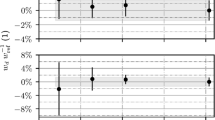Abstract
In this study 2k experimental designs were used for the optimization of an instrumental neutron activation analysis method for the determination of bromine, chlorine, magnesium, manganese, potassium, sodium and vanadium in biological matrix materials. Depending on radionuclide half-lives, 23 or 24 experimental designs were used with irradiation time, sample–detector distance, counting time and sample decay time as factors. Gamma ray spectrometer, comparator mass fraction and sample mass were kept constant. Optimized irradiation and measurement conditions were established based on the experimental design results that used z-scores as response on a reference material for the various elements and experimental conditions.










Similar content being viewed by others
References
Eriksson L, Johasson E, Kettaneh-Wold N, Wiktrom C, Wold S (2008) Design of experiments: principles and applications. MKS Umetrics, Umea
Barros Neto B, Scarminio IS, Bruns RE (2010) How to make experiments: research and development in science and industry, 4th edn. Bookman, Porto Alegre (in Portuguese)
Petroni R, Moreira EG (2015) INAA method optimization using a 2k factorial design. J Radioanal Nucl Chem 306:623–629
Ehmann WD, Vance DE (1991) Radiochemistry and nuclear methods of analysis. Wiley, New York
Greenberg RR, Bode P, Fernandes EAN (2011) Neutron activation analysis: a primary method of measurement. Spectrochim Acta Part B 66:193–241
Montgomery DC (2001) Design and analysis of experiments, 5th edn. Wiley, New York
Box GEP, Hunter WG, Hunter JS (2005) Statistics for experiments. Wiley, New York
Teófilo FR, Ferreira CMM (2002) Chemometrics II: spreadcheets for experimental design calculations, a tutorial. Quím Nova 29(2):338–350 (in Portuguese)
Melquiades FL, Parreira PS, Yabe M, Corazza MZ, Funfas R, Appoloni CR (2007) Factorial design for Fe, Cu, Zn, Se and Pb preconcentration optimization with APDC and analysis with a portable X-ray fluorescence system. Talanta 73:121–126
Snetsinger P, Alkhatib E (2018) Flexible experiment introducing factorial experimental design. J Chem Educ 95:636–640
Chu SYF, Ekström LP, Firestone RB (1999) The Lund/LBNL nuclear data search: table of radioactive isotopes, database version 1999-02-28. http://nucleardata.nuclear.lu.se/toi/. Accessed 27 Aug 2019
Moreira EG, Vasconcellos MBA, Maihara VA, Catharino MGM, Saiki M (2018) Interlaboratory comparison for the characterization of a Brazilian mussel reference material. J Braz Chem Soc 29(4):823–830
Minitab 18 Statistical Software (2017) Minitab, State College
NIST/SEMATECH e-Handbook of Statistical Methods (2013) http://www.itl.nist.gov/div898/handbook/. Accessed 30 Aug 2019
Thompson M, Ellison SLR, Wood R (2006) The international harmonized protocol for the proficiency testing of analytical chemistry laboratories (IUPAC Technical Report). Pure Appl Chem 78(1):145–196
Acknowledgements
Authors and indebted to the Brazilian Nuclear Energy Commission (CNEN) for financial support and the Brazilian Coordination for the Improvement of Higher Education Personnel (CAPES) for the provided grant.
Author information
Authors and Affiliations
Corresponding author
Additional information
Publisher's Note
Springer Nature remains neutral with regard to jurisdictional claims in published maps and institutional affiliations.
Rights and permissions
About this article
Cite this article
Santos, U.P.M., Lourenço, F.R. & Moreira, E.G. Experimental design and z-score results are useful tools for optimizing instrumental neutron activation analysis procedures. J Radioanal Nucl Chem 325, 707–718 (2020). https://doi.org/10.1007/s10967-020-07150-4
Received:
Published:
Issue Date:
DOI: https://doi.org/10.1007/s10967-020-07150-4




